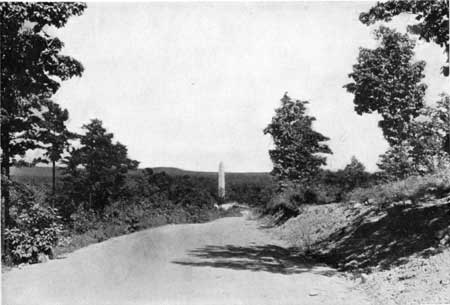MENU
|
Glimpses of Historical Areas East of the Mississippi River |
|
The Revolution |
|
SOUTH CAROLINA |
Special Feature: The site of an American victory at a critical point in the Revolutionary War, October 7, 1780.

Federal Monument Erected in Memory of the Troops
that Participated in the Battle of Kings Mountain.
(Photo by Rinehart)
OF THE battle of Kings Mountain the historian Bancroft said that it was "like the rising of Concord, and in its effects like the success of Bennington." The victory was won in the darkest period of the Revolutionary War in the South, not long after the disastrous American defeat at Camden, S. C., and fired the Patriots with new zeal. Kings Mountain National Military Park, which commemorates this celebrated Revolutionary battle on October 7, 1780, is located in York County in north central South Carolina.
After the failure of their attempt to conquer the Northern States, the British in 1779 again turned their attention to the South, overrunning Georgia and part of South Carolina. Then, on August 16, 1780, they completely defeated the Americans under Gates at Camden. The conquest of the entire South seemed to be inevitable. The sole armed force of any consequence south of New Jersey was the remnant of Gates' army, consisting of about 700 men. Under these circumstances Cornwallis marched unopposed into North Carolina as far as Charlotte, and at the same time sent Maj. Patrick Ferguson to the foothills of the Alleghenies to suppress the troublesome Whig mountaineers and arouse the Tories.
Disturbed by the forays of the backwoodsmen, Ferguson warned them that if they did not desist from their opposition to the British arms, he would "march his army over the mountains, hang their leaders, and lay their country waste with fire and sword." But this threat only aroused the mountaineers to greater efforts. Under their leaders, William Campbell, Isaac Shelby, and John Sevier, they assembled from the western counties of Virginia, North Carolina, and South Carolina and moved rapidly against Ferguson. Their attacking force, consisting of about 900 men, all good marksmen and sturdy fighters, was placed under the command of Colonel Campbell. The British force was composed of about 1,100 Tory regulars and militia. Taking a position on the crest of a lateral spur of Kings Mountain, Ferguson declared that "God Almighty and all the Rebels of Hell could not drive him from it." But against the firm determination of the frontiersmen his position was not as formidable as he boasted. About 3 o'clock on the afternoon of October 7, 1780, he was surrounded by the Americans. Their fighting was not scientific, according to European standards, but it proved effective. Dismounting from their horses, they swarmed up the mountain on every side, and firing from behind trees, used their rifles with deadly effect. The Tories, gallantly led by Ferguson, made a brave fight. Three times they drove the mountaineers back with the bayonet, but each time the latter returned to the assault. Ferguson, seeing that his situation was desperate, made a bold dash on horseback for freedom, but fell dead, pierced by several bullets. The Tory losses were about 225 killed, 163 wounded, and 716 captured. The American casualties were 28 killed and 62 wounded.
The victorious frontiersmen returned quickly to their homes. The news of their brave fight, however, spread rapidly in every direction. It heartened the militia in North Carolina and Virginia, and greatly discouraged the Tories throughout the South. Surrounded by a hostile population, Cornwallis halted his forward movement.
NEXT> Cowpens National Battlefield Site
 Top
Top
Last Modified: Thurs, Nov 23 2000 10:00:00 pm PDT
http://www.cr.nps.gov/history/online_books/glimpses3/glimpses2d.htm
![]()
